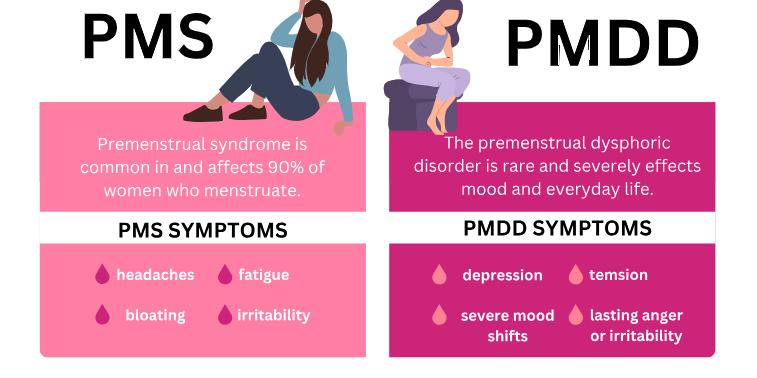While Premenstrual Dysphoric Disorder (PMDD) and Premenstrual Syndrome (PMS) are similar disorders, their effects on day-to-day functioning, severity, and symptoms may vary. In order to clarify, Dr. Shobha Gupta explains it through following points:
1. PMDD is a severe version of PMS marked by more acute emotional and physical symptoms. PMS is a collection of physical and emotional symptoms that appear in the days or weeks prior to menstruation.
2. PMDD symptoms are more common than PMS symptoms, which are more varied and can include severe mood disturbances including depression, anxiety, and irritability. • PMS symptoms might include mood swings, bloating, breast tenderness, fatigue, and changes in appetite.
3. While the symptoms of PMS are often mild to moderate and do not substantially hinder everyday functioning, those of PMDD are severe enough to cause problems for a person›s ability to go about their daily life, maintain relationships, and work.
4. The symptoms of PMDD normally begin two weeks before menstruation, during the luteal phase of the menstrual cycle, and terminate when menstruation begins, whereas the symptoms of PMS usually start one to two weeks before menstruation and get better once menstruation starts.
How to diagnose it?
While diagnosing PMDD entails recording symptoms across several menstrual cycles and ruling out other possible causes, diagnosing PMS is based on the occurrence of recurrent symptoms in relation to the menstrual cycle. The signs and symptoms have to be bad enough to interfere with day-to-day activities.
Considering that underlying anxiety and sadness are linked to both PMDD and PMS, it’s possible that the hormonal changes brought on by the menstrual cycle worsen the symptoms of mood disorders. While PMS is believed to be a normal part of the monthly cycle and affects many women to varying degrees, PMDD is a more severe and serious illness that may require medical intervention. If someone suspects they may have PMDD, they should consult a healthcare professional so they can be appropriately diagnosed and treated” said Dr. Shobha Gupta.
Treatment for PMDD
Premenstrual dysphoric disorder (PMDD) is usually treated with a mix of medication, psychotherapy, and lifestyle modifications. It’s important to speak with a medical expert to decide on the best course of action based on your unique needs and the severity of your symptoms. Your doctor may advise you to follow specific dietary and lifestyle guidelines; prescribe hormone treatments or antidepressants; or advise you to take supplements such as magnesium, calcium, or vitamin D.
It’s essential to keep in mind that every individual reacts to treatment in a different way, and a doctor will tailor the plan of action to each patient’s needs. Regular monitoring and adjustments to the treatment strategy can be necessary. Keeping lines of communication open with medical professionals is also essential for resolving any issues or negative effects related to the selected course of treatment” concluded Dr. Shobha Gupta.
The author is the Medical Director, Gynecologist and IVF Specialist from Mother’s Lap IVF Centre in New Delhi and Vrindavan.







